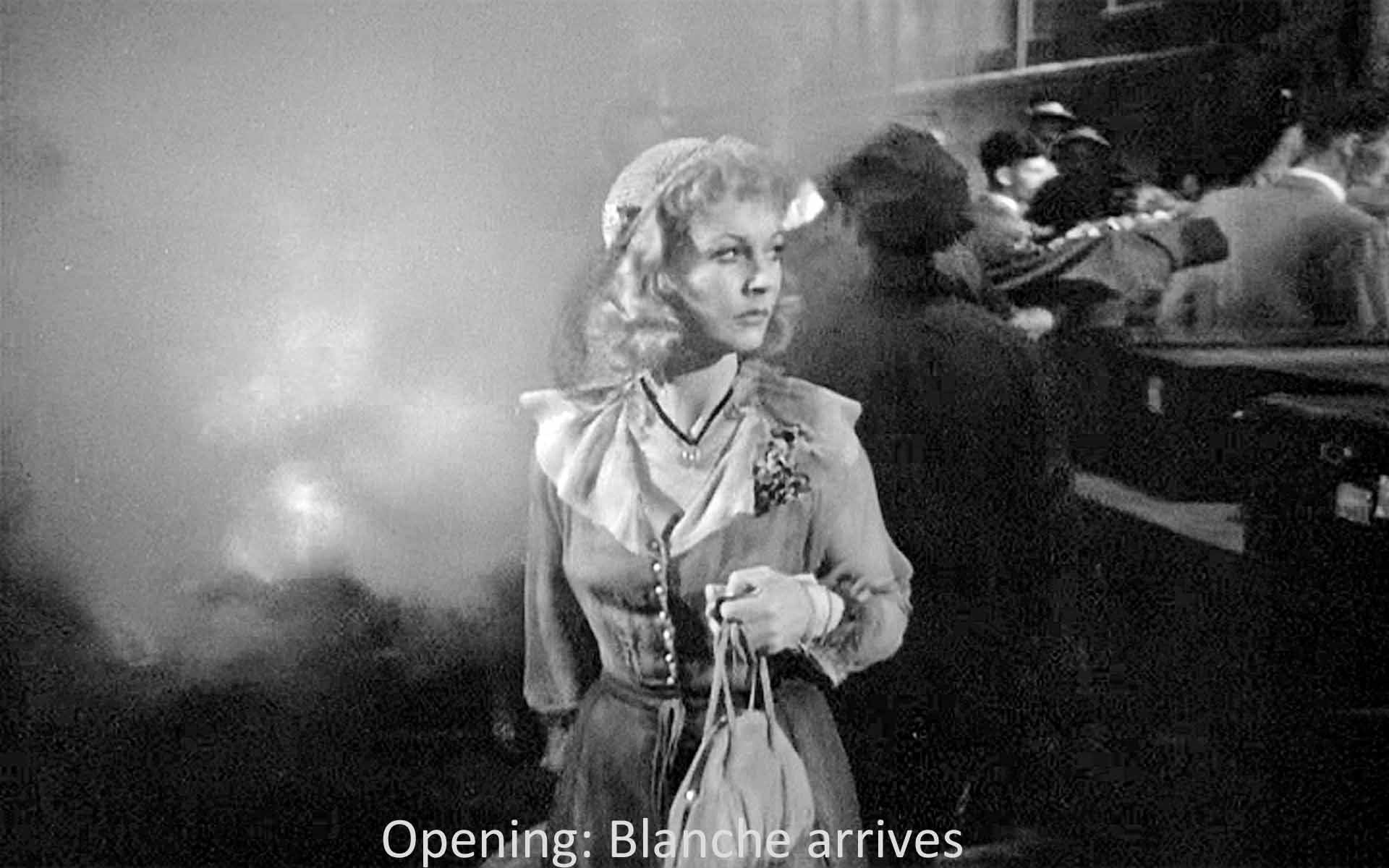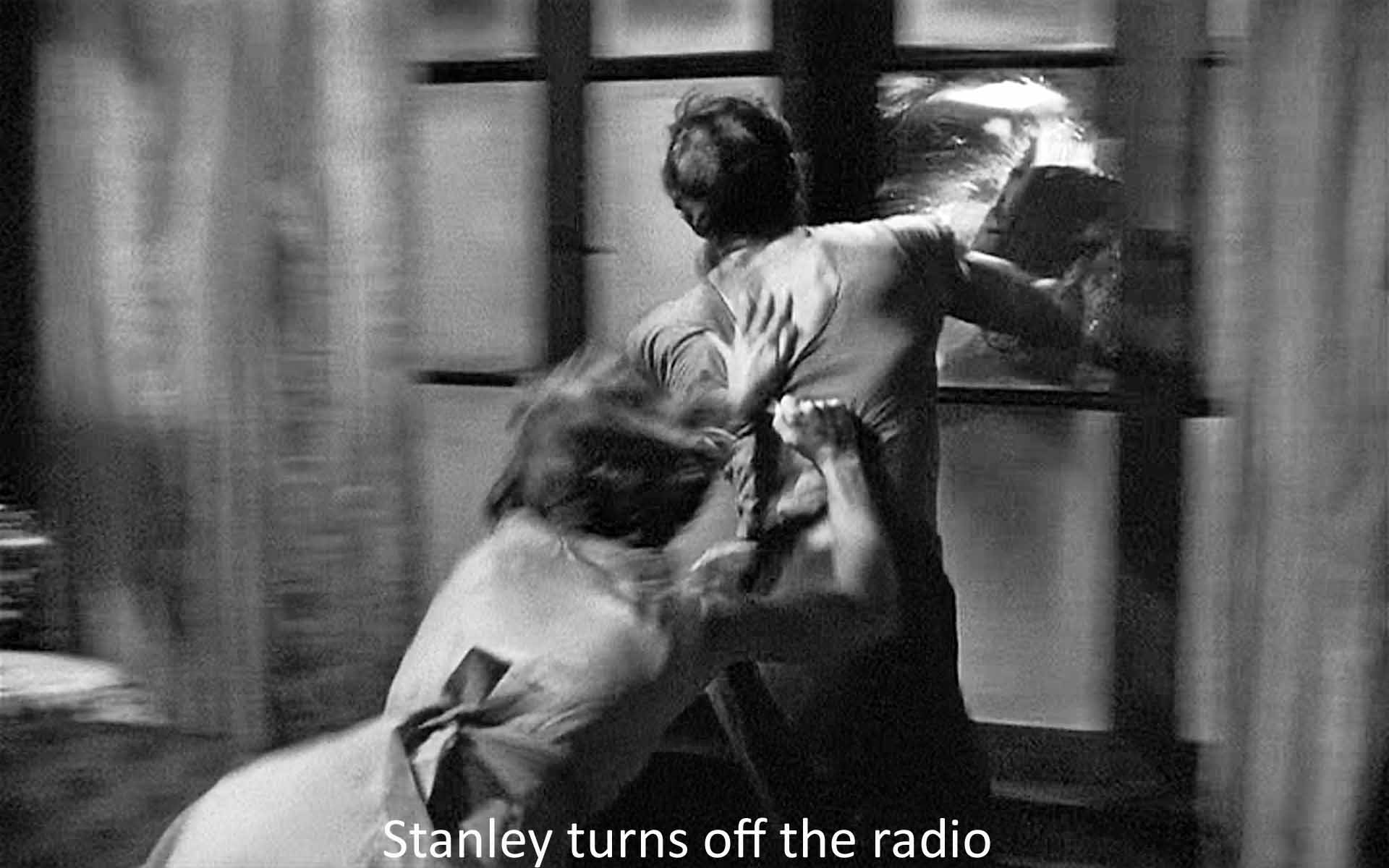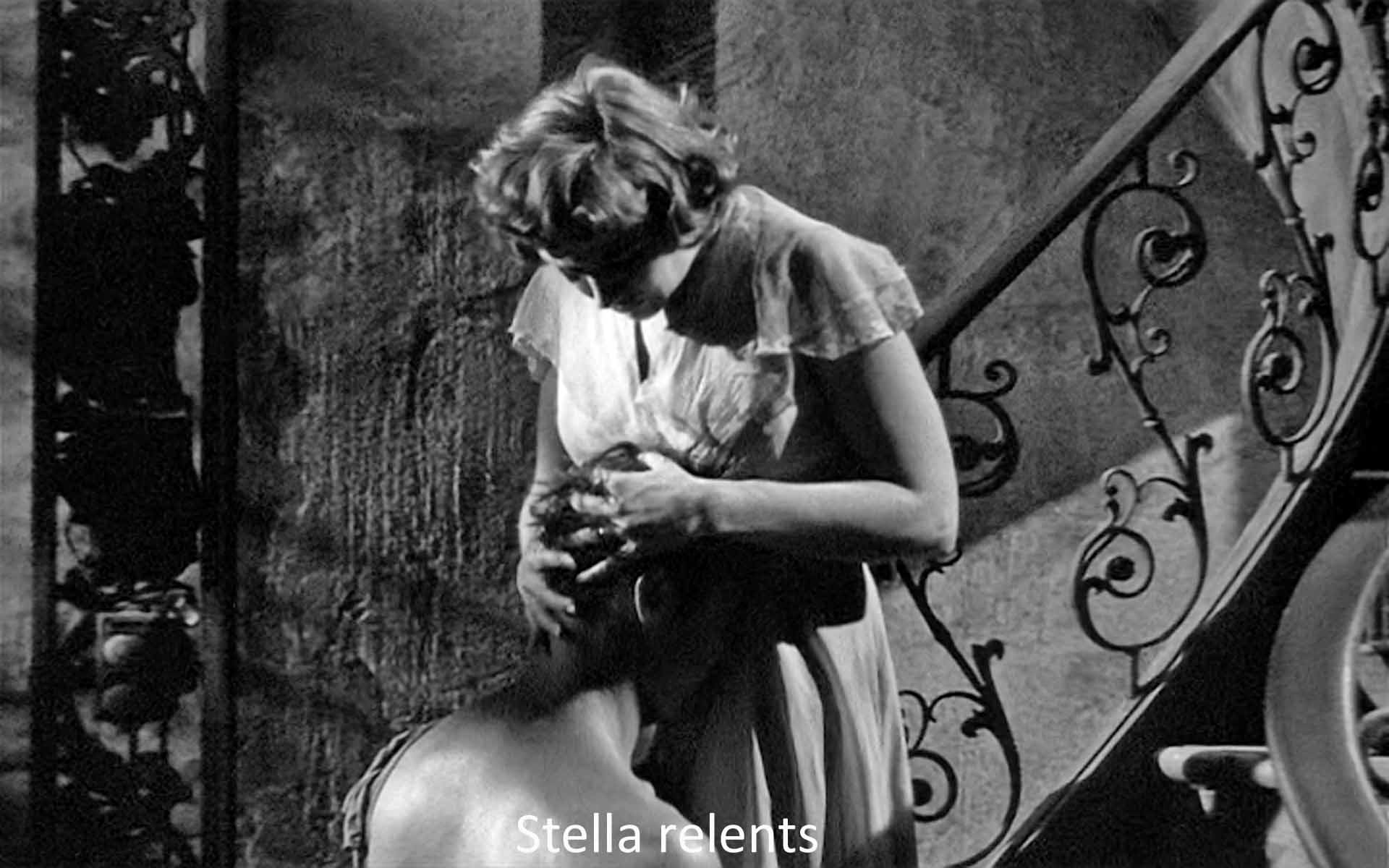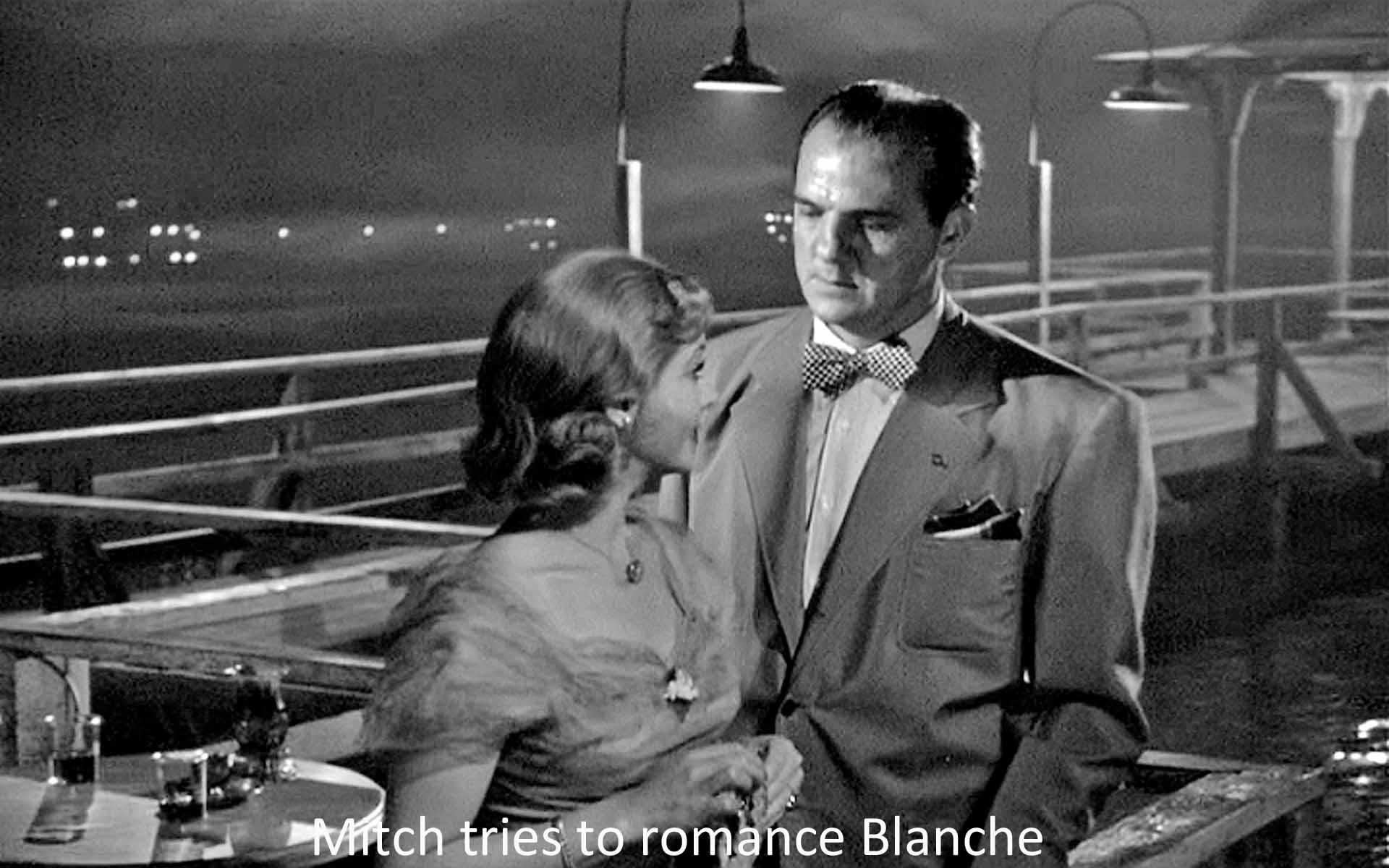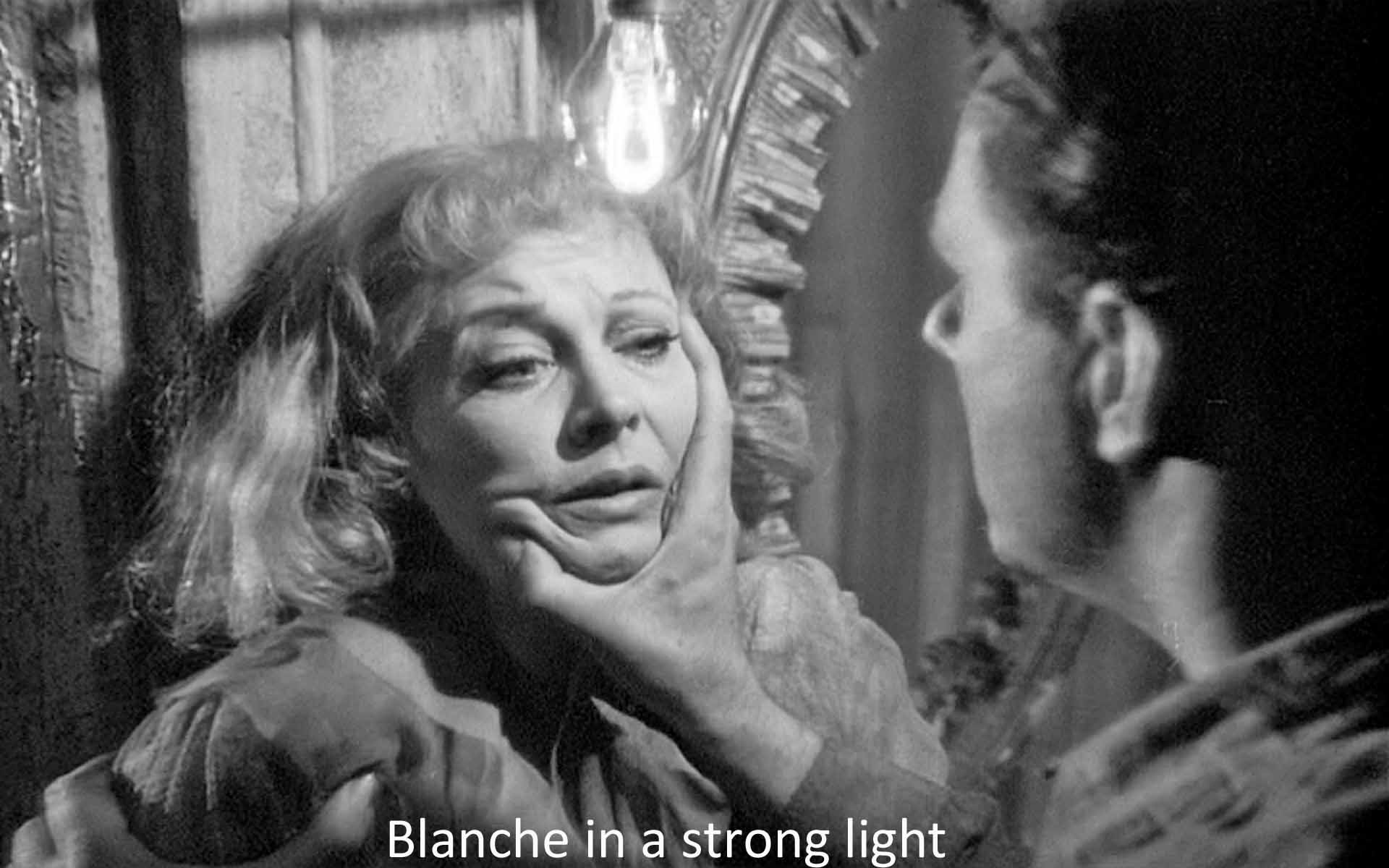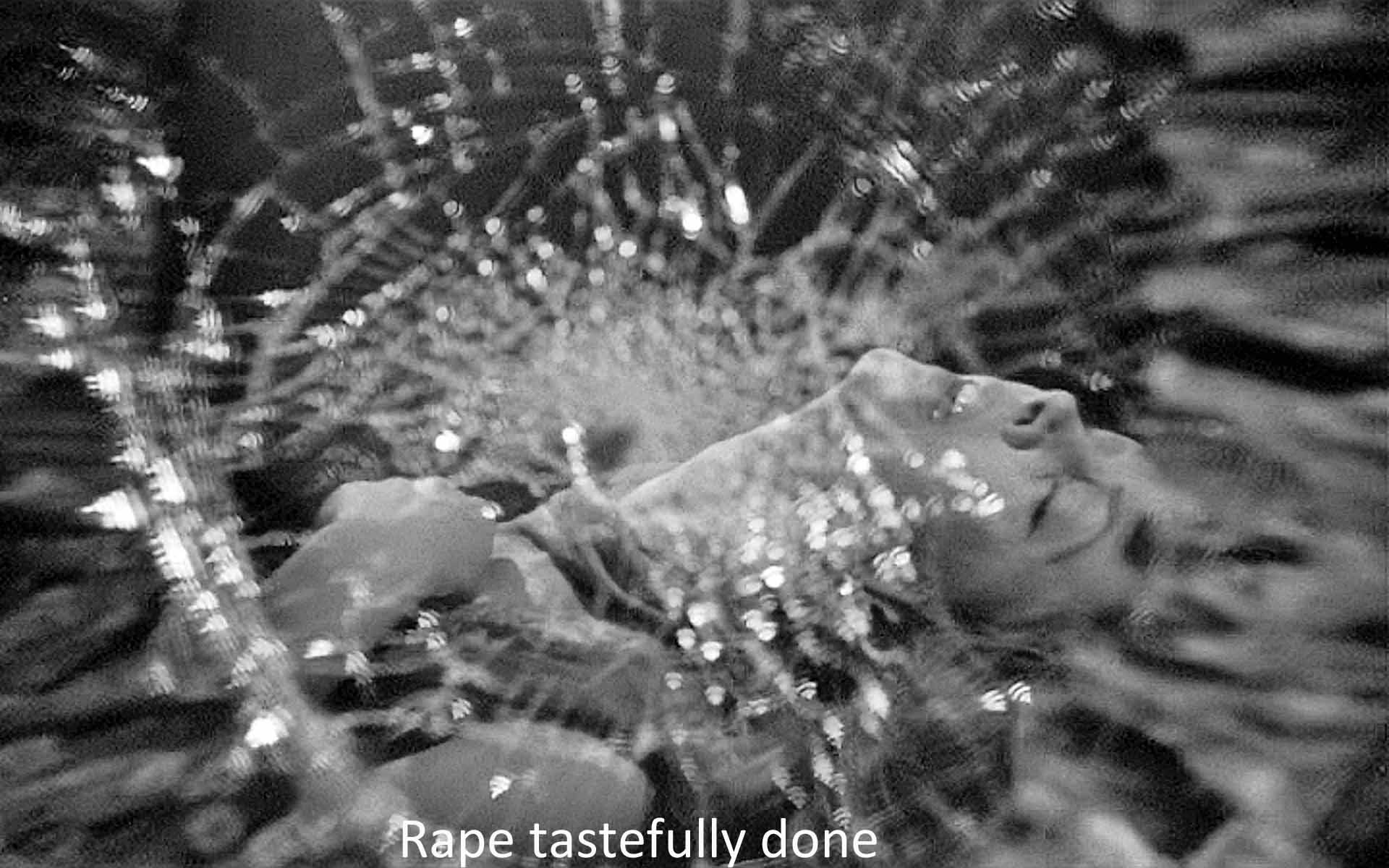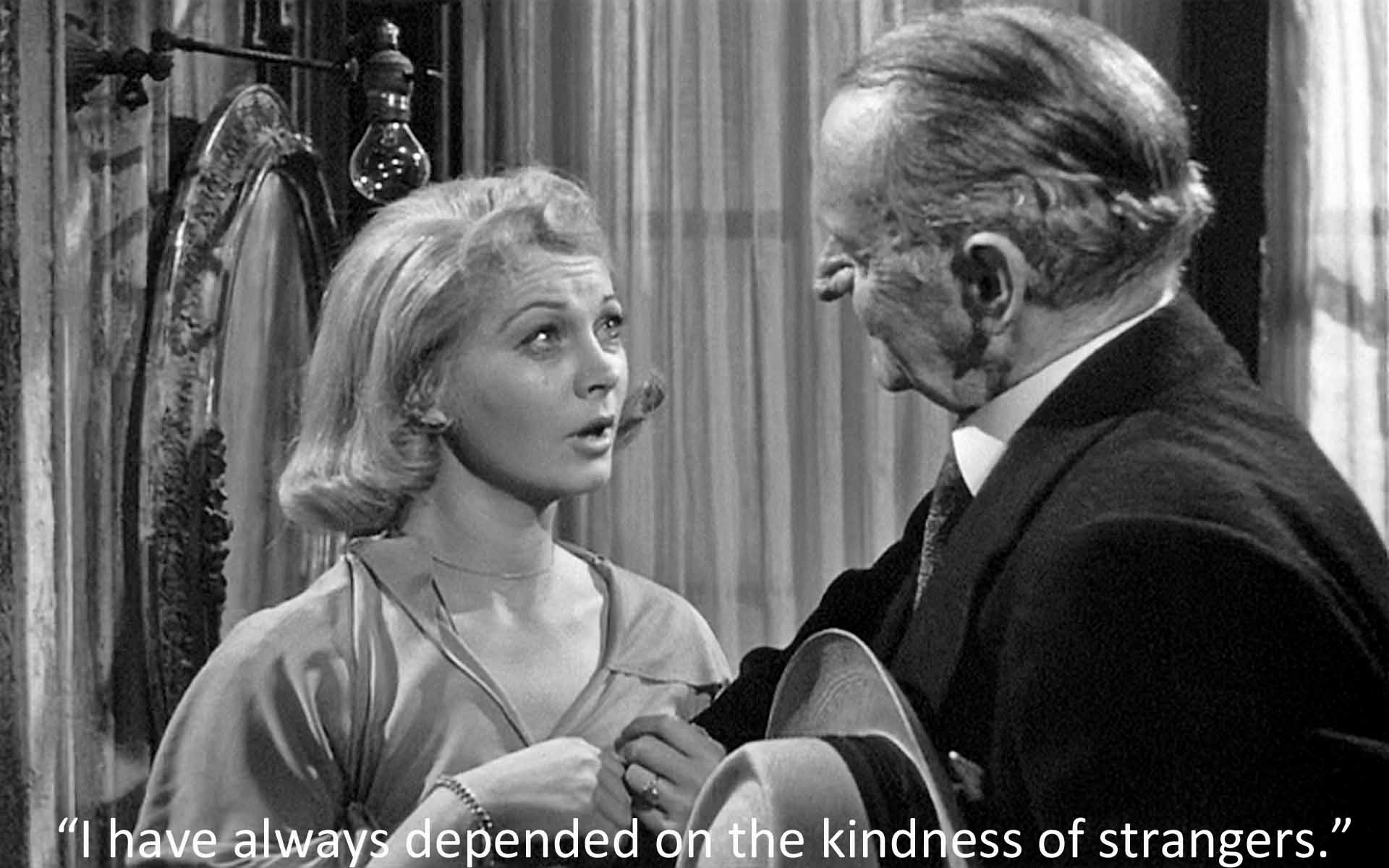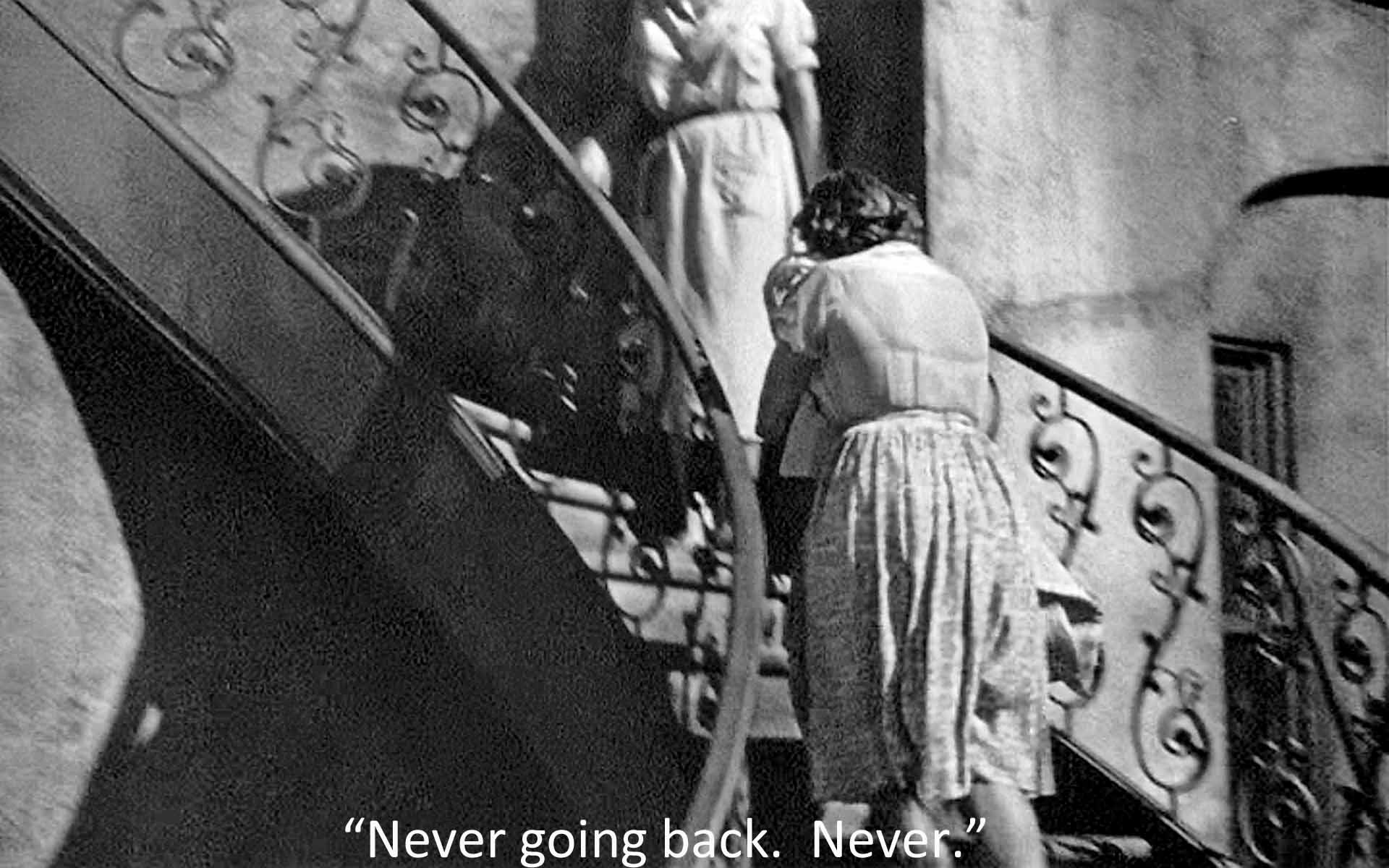Streetcar ends unhappily, but it’s not a tragedy, strictly speaking. We do not start with a character who is high and then brought low. Blanche Dubois (Vivien Leigh) is at her nadir when she arrives at the Kowalski household. Rather this is a story in which two forces grind at each other until one crushes the other. Stanley Kowalski (Marlon Brando) embodies a brute, Stone Age masculinity, loud, violent, intensely sexual, given to savage rages. Blanche Dubois represents (at least at first) a delicate femininity, all magic and enchantment (plus some behind-the-scenes scheming), until Stanley exposes her, rapes her, and she collapses into madness. In between are two characters, Mitch (Karl Malden) and Stanley’s wife Stella (Kim Hunter) whose allegiance is to be won by one side or the other.
That is only a broad outline. Tennessee Williams’ play and screenplay are brilliant, full of subtle little gems, yet large in theme. In a way, the play dominates the movie. Streetcar is very much a staged play as in movies of the 1910s). Kazan used the original Broadway cast (except for Jessica Tandy’s Blanche), and he used the original Broadway set, adapted to a movie sound stage. The sound stage had room for two sets, the exterior of the Kowalski home and the interior, both very like the Broadway set. The interior was specially constructed so that it could contract as the story proceeded, to give a feeling of claustrophobia and Blanche’s narrowed options and increasing madness.
It was important to “open the film up,” however. Kazan added a few scenes off that set: the bowling alley, the “pavilion” where Mitch and Blanche romance (done on a floodable sound stage), and the entrance, the opening shot, in the train station. Kazan took the whole cast to New Orleans for that, and like all opening shots it cues us to the film’s themes as a whole.
Taxis roll up to a train station, opulence Blanche and Stella cannot share. A train comes in (Stanley’s phallic power) and the first person off the train we see is a bride in all her finery (the marriage issue for both Stella and Blanche). Then there is a cloud of steam from which Blanche emerges (the confusing aura with which she surrounds herself). Perplexed, she asks for directions from a young sailor (Blanche’s thing for young men, her husband, her students, the paper boy). “Why, they told me to take a streetcar named Desire, and then transfer to a one called Cemeteries and ride six blocks and get off at Elysian Fields!" Again, major themes: desire is what drives all four principal characters; cemeteries, the theme of aging and death (Blanche’s houseful of dying women, the “flowers for the dead” woman who frightens Blanche) or perhaps, since New Orleanians speak French, le petit mort, orgasm; and the Elysian contentment after same. The opening Kazan created is remarkably dense.
Other things added to the brilliance of Streetcar. The producer Charles K. Feldman was able to work outside the studio system. Instead of picking from a menu of people that Warner Brothers had on contract, he could hire people from outside the studio. That way, Kazan was able to use his Broadway cast and pick the cameraman he wanted, Harry Stradling, and the composer, Alex North. North produced a score quite different from the usual Hollywood strings. He did not adopt the conventional approach of a leitmotif for each character. Instead he tried to represent the relations between the characters by themes: jazz for Stanley’s virility and a sad, romantic tune for Blanche’s fantasies. Combining these themes allowed Stanley to have moments of tenderness with Stella, and Blanche to have her final painful acceptance of her age.
And then there was Kazan’s direction. Martin Scorsese's A Letter to Elia states something many people have said about Kazan, that he had to get beyond theater directing to become a good filmmaker. I don’t think he had done that by the time of Streetcar, although I think it is a great film. But it is a great film because of Tennessee Williams’ script (and Kazan worked intensely with Williams on that) and because of the acting that was Kazan’s primary focus. He had been a key member of the Group Theatre, and he was one of the founders of the Actors Studio, the High Church of method acting (still in operation). And it is a great film because of the acting.
Kazan thought of himself as an actor’s director. He described directing as “your own talent in stirring up the actors.” Even during the long waits that actors suffer when filming, Kazan would pop questions about the way the actor conceived the character. He thought of actors as very much his collaborators. “You can’t storyboard. You have to wait to see what the actor’s gonna give you.” “A good director’s not sure when he gets on the set what he’s gonna do.” And no question—the acting in Streetcar is astounding.
Of his film directing, “I don't have great range,” Kazan wrote. “I am no good with music or spectacles. The classics are beyond me. . . . I am a mediocre director except when a play or film touches a part of my life's experience. . . . I do have courage, even some daring. I am able to talk to actors. . . . to arouse them to better work. I have strong, even violent, feelings, and they are assets.” As for actors, he said, “Now what I try to do is get to know them very well. I take them to dinner. I talk to them. I meet their wives. I find out what the hell the human material is that I'm dealing with, so that by the time I take an unknown he's not an unknown to me.” These unknowns would include James Dean, Warren Beatty, Andy Griffith, Lee Remick, most notably Marlon Brando, and many others to whom Kazan gave their first starring roles. He himself wrote in Kazan on Directing, that he tried to find some aspect of himself in the major characters in a film or play he was about to direct. Then he would choose actors he thought would be able to find still other dimensions to the character. Like many directors (John Huston, Woody Allen), he thought a director should not mix into what the actors themselves had arrived at. He should intervene only if the actor seemed uncertain what to do. John Lahr summed him up: “A sort of entrepreneur of emotional complexity, he had a gift for releasing the articulate energy of actors and for turning psychology into behavior.”
The psychology comes first, before the language. Lee Strasberg would say, “The text is your enemy.” Merely acting the words is lifeless. Kazan would use an Actors Studio exercise called “paraphrasing dialogue.” Because the character’s emotional life exists before the words, actors should first get the feeling using their own words. Then they can speak the written lines with true emotion.
People sometimes say of Brando’s performance in Streetcar, both play and film, that it was the most important performance in the twentieth century, because it put method acting at front and center. I would be hard pressed to name an actor post-1950 who was not at least influenced by the Method (Lee Strasberg’s term for his adaptation of Konstantin Stanlislavsi’s principles stated in three famous books). Kazan took from Stanislavski the ethical idea that theatre (and movies) had to be a force for social change (more evident in Gentleman’s Agreement, Viva Zapata!, or On the Waterfront than Streetcar). What we see in Streetcar is the basic Stanislavskian principle: the actor should translate the psychology of the character into behavior—that is the essence of the actor’s performance.
If I observe Brando’s physical performance carefully, it seems to me that he does very little with his eyes, except to stare intently at people. By contrast, his mouth is always in motion. Either he’s chewing gum or rolling a toothpick around or smoking or drinking a beer—or shouting. (Psychiatrists, enlisted by a biographer, diagnosed him as having an “oral fixation.”) That mouth, so to speak, says it all—restless energy. From time to time he explodes into loud and violent rage, and after I have seen one or two of these I read him as simmering all the time, volcanic, about to have a tantrum like the child he partly is. I read him as filled with inner tensions between the sexual, driving man and the helpless baby he can be to Stella. And of course he uses his biceps and chest and that t-shirt (specially tailored to be skin-tight). It gave rise to the gibe at Method acting as “the torn t-shirt school.” Certainly the Method is perfectly suited to the character Brando is acting, the Method that puts such emphasis on the physical expression of psychological states. Even so, Brando was able to find the comedy in the character, his riff about the Napoleonic Code or his irritation at losing at poker or his novel method of clearing the table.
Leigh’s performance is anything but Method. She replaced Jessica Tandy who did Blanche on Broadway because the studio wanted the film to have a recognizable star. She had acted Blanche for six months in the London production directed by Laurence Olivier, equally non-Method (or anti-Method). Yet she seems to me to express inner states every bit as successfully as Brando, even though her character tries mostly to keep her perverse inner self buried under a Southern belle’s lacy vamping. “I want magic.” She only lets it out when Stanley “wises up” Mitch.
Brando is her opposite. He wants his inner self to be just under the surface and ready to explode. Her eyes, unlike his, are constantly working. She rolls and blinks them flirtatiously, radiating cuteness and childishness and evasion—and sex. Or she looks directly when she is getting down to business with Stella. Her mouth has a girlish simper that she can turn on and off like a light bulb. And her voice! It is always high register, “cute,” until she gets down to the painful realities with Stella or Mitch. Critics agreed that her Blanche was sexier than Tandy’s. Her famous curtain line, “I have always depended on the kindness of strangers”—terribly ironic and bitter, given her encounters with strangers in the Hotel Flamingo—she delivers with the same girlish look up as all her flirtations. She won the Best Actress Oscar, while Brando was passed over for Bogart in African Queen.
An impressive moment for Leigh comes when Mitch forces Blanche to stand under a strong light. She ages instantly (the make-up department no doubt helped here), but all the tension in her face that maintained the cuteness and flirtiness of a Southern belle drains out, and her face melts into that of a suffering forty-year old woman.
As for Mitch, he plays the bashful lover to a T. He has a soft, diffident smile, and he leans over Blanche protectively. Malden keeps his lips slightly parted, expectant, and his face reads both perplexity and eagerness as she weaves her confusing spell. How could a man with that nose be threatening? But he can. When he finally confronts her, he turns erect, masculine, loud. The leaning over becomes a threat of rape. Karl Malden won the Best Supporting Actor Oscar.
Stella would seem to offer much less for an actress than Blanche, but Kim Hunter has her moments. (She won Best Supporting Actress.) She has a little pout of distress and puzzlement as she tries to tame the beast she’s married to. Often she resorts to beating on him physically—to no effect. After he has hit her and she has retreated to the flat upstairs and he is crying “Stella-a-a!”, she has a wonderfully sultry walk down a flight of stairs and into his arms. The next morning she is kittenish, radiating sexual contentment. She describes her wedding night, and Blanche complains that she is talking about nothing but desire. Yes. But seasoned with a little momentary guilt conveyed by fine acting.
Desire. The title says it all. Each of the characters is driven by one or another form of sexual desire. Needless to say, in 1951 the film bumped into various censors, the Breen Office enforcing the Motion Picture Production Code and the Catholic Legion of Decency. Their position was, as stated by Richard Schickel in the DVD commentary: “The moral issues must in all movies take precedence over aesthetic issues.”
Getting Streetcar past the Breen Office and the Legion of Decency involved making various changes. The Breen Office insisted that the rape be done “tastefully.” How do you do a rape tastefully? You cut away to a smashed mirror and a firehose spurting onto the street. Other changes involved toning down Stella’s very sexual return to Stanley after he has hit her. They even censored passages of music—“too sultry.” Luckily the pre-alteration segments of film were found, and we now see the version that Kazan originally filmed.
Elia Kazan’s lasting contribution was to dislodge American movies from the childishly moralistic, sex-free, good-guys-bad-guys characterizations in which they had been locked since the beginning of film in America. Streetcar with its method acting was one film that started the decline. A more decisive move came with The Moon is Blue (1951), an Otto Preminger film. United Artists decided to release it despite the Breen Office and various state bans. Courts, and ultimately the Supreme Court, threw out the bans, and the picture was a success. Once the studios realized they could ignore the Breen Office and the Legion of Decency and the other censors, they substituted their own milder (and pleasantly ineffective) ratings system. Nowadays, you can see virtually anything on American screens, including cable (but not network) tv. So be it.
Streetcar remains one of the great American films with the script and the acting its huge achievements. Unfortunately, though, when people think of Kazan’s films and especially On the Waterfront (1954), they remember Kazan’s shameful capitulation to the House Un-American Activities Committee in 1951. Brando called it “finking“ on his friends, and even when Kazan received a Lifetime Achievement award in 1999 many slammed the Motion Picture Academy for so recognizing him.
In 1951 HUAC was riding high on the crest of the anti-Communism prompted by the start of the Cold War in the late ‘40s. By forcing people in the movie and other industries (including college professors) to confess publicly that they had once belonged to the Communist Party or other left-wing organizations, they savaged careers and ruined lives. It was a shameful and foolish episode in America’s history, culminating in the rise and fall of the conman Joseph McCarthy.
In Hollywood, those called on to confess their errors faced a difficult choice: fight, flight, or surrender. Those who resisted (by pleading the Fifth Amendment) and those who fled to Europe were jailed or blacklisted from the American film industry. America lost some fine talents: Jules Dassin, Abraham Polonsky, John Howard Lawson, Dalton Trumbo, Ring Lardner Jr., Edward Dmytryk, and many others.
Kazan had been told by the studio bosses that if he refused to testify he would never make another film in America, and he desperately wanted to make movies. Directing was his life. John Lahr quotes a conversation Kazan had with Arthur Miller before his decision: “If he refused to testify, he told Miller, he would say to himself, “What the hell am I giving all this up for? To defend a secrecy I didn't think right and to defend people who'd already been named or would soon be by someone else?” That is, the committee already knew who had been communists. They just wanted prominent people to confess the error of their previous thinking and conform to what the government now thought they should think. I can understand Kazan’s choice but I cannot approve of it, even though I wonder, if I myself had been faced with the same choice, what I would have done.
